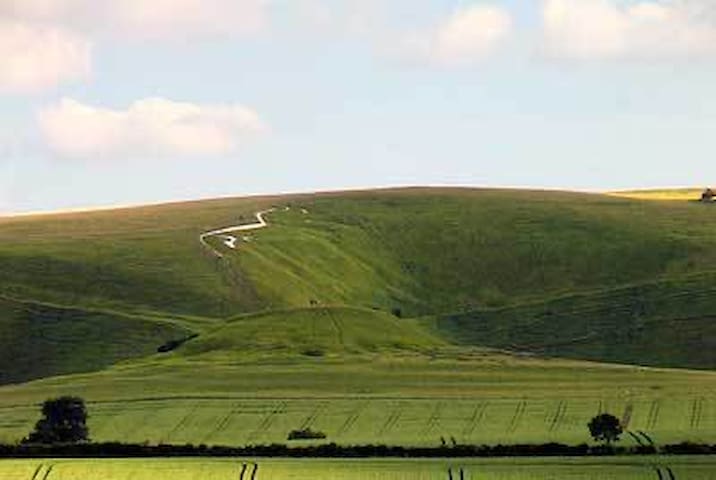Sightseeing
Ancient rolling downland, home to an enigmatic chalk hill figure
The internationally-renowned Bronze-Age Uffington White Horse can be seen for miles away leaping across the head of a dramatic dry valley in the Ridgeway escarpment.
The horse is only part of the unique complex of ancient remains that are found at White Horse Hill and beyond, spreading out across the high chalk downland.
The Manger, a dramatic dry valley has steep rippled sides left from the retreating permafrost during the last Ice Age. These ripples are known as the Giant's Steps.
To the east of the Manger lies Dragon Hill, a small roundish hill with a flattened top. It is said to be the site where St. George, England's patron saint, slew the dragon. The blood poisoned the ground and left a white chalk scar for all to see.
Crowning White Horse Hill is an Iron Age hillfort known as Uffington Castle. A simple design of one rampart and ditch, the castle at 860 feet (262m) above sea level forms the highest point in Oxfordshire, with views for miles around over six counties.
Across the property Burial Mounds can be spotted. These date from the Neolithic period and have been reused up to the Saxon age. The largest contained 47 skeletons and this can be seen as you walk up to the Horse from the car park, if you look carefully.
78 recommandé par les habitants
Uffington White Horse
Dragon Hill RoadAncient rolling downland, home to an enigmatic chalk hill figure
The internationally-renowned Bronze-Age Uffington White Horse can be seen for miles away leaping across the head of a dramatic dry valley in the Ridgeway escarpment.
The horse is only part of the unique complex of ancient remains that are found at White Horse Hill and beyond, spreading out across the high chalk downland.
The Manger, a dramatic dry valley has steep rippled sides left from the retreating permafrost during the last Ice Age. These ripples are known as the Giant's Steps.
To the east of the Manger lies Dragon Hill, a small roundish hill with a flattened top. It is said to be the site where St. George, England's patron saint, slew the dragon. The blood poisoned the ground and left a white chalk scar for all to see.
Crowning White Horse Hill is an Iron Age hillfort known as Uffington Castle. A simple design of one rampart and ditch, the castle at 860 feet (262m) above sea level forms the highest point in Oxfordshire, with views for miles around over six counties.
Across the property Burial Mounds can be spotted. These date from the Neolithic period and have been reused up to the Saxon age. The largest contained 47 skeletons and this can be seen as you walk up to the Horse from the car park, if you look carefully.
Wayland's Smithy is an atmospheric historic site about a mile's walk along the Ridgeway from the Uffington White Horse. A Neolithic chambered long barrow, it was once believed to have been the home of Wayland, the Saxon god of metal working.
Human remains found on the site indicate that 14 people were interred in an earlier burial structure between 3590 and 3550 BC. Between 3460 and 3400 BC a second far larger barrow was constructed on top. It is the ruins of this that can be explored by visitors to the site today.
11 recommandé par les habitants
Wayland's Smithy
Wayland's Smithy is an atmospheric historic site about a mile's walk along the Ridgeway from the Uffington White Horse. A Neolithic chambered long barrow, it was once believed to have been the home of Wayland, the Saxon god of metal working.
Human remains found on the site indicate that 14 people were interred in an earlier burial structure between 3590 and 3550 BC. Between 3460 and 3400 BC a second far larger barrow was constructed on top. It is the ruins of this that can be explored by visitors to the site today.

